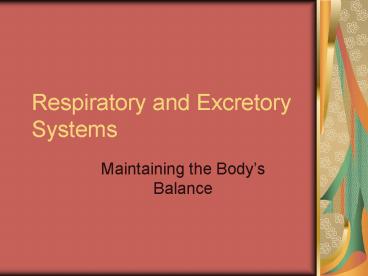Respiratory and Excretory Systems - PowerPoint PPT Presentation
1 / 17
Title:
Respiratory and Excretory Systems
Description:
8. Windpipe directs air from the pharynx to the bronchi. 9. Directs air into the left lung. 10. Small branches of the bronchi that direct air to the alveoli ... – PowerPoint PPT presentation
Number of Views:137
Avg rating:3.0/5.0
Title: Respiratory and Excretory Systems
1
Respiratory and Excretory Systems
- Maintaining the Bodys Balance
2
Structures
- Nasal cavity
- Mouth
- Larynx
- Lung
- Right bronchus
- Diaphragm
- Pharynx
- Trachea
- Left bronchus
- Bronchiole
- Alveoli
3
Functions
- Mucus cleans, warms and moistens air
- Alternative passage for air to enter the system
- Voice box that protects the vocal chords
- The main organ of the respiratory system
- Tube that directs air into the right lung
- Dome-shaped muscle that allows the chest cavity
to expand and contract during breathing
4
Functions
- 7. Top of the throat, epiglottis controls entry
of air - 8. Windpipe directs air from the pharynx to the
bronchi - 9. Directs air into the left lung
- 10. Small branches of the bronchi that direct air
to the alveoli - 11. Small membrane-bound sacs that exchange gases
from the air to the blood.
5
Cardiopulmonary Connection
6
Cardiopulmonary Connection
7
Respiration vs. Breathing
- The lungs are the main organs of the respiratory
system. They function because the diaphragm, a
large dome-shaped muscle, controls the size of
the chest cavity. Breathing allows the body to
acquire oxygen for cellular respiration and to
excrete carbon dioxide waste from cellular
respiration.
8
Breathing
9
The Digestion Connection
- Food enters the digestive system where it is
broken down into the small molecules that make up
lipids, proteins, and carbohydrates. The
circulatory system distributes these nutrients to
cells in the body. Glucose is one of the main
nutrients needed by cells for mitochondrial
respiration.
10
The Digestion Connection
- Source http//static.howstuffworks.com/gif/diabet
es-glucose-regulation.gif
11
Maintaining Glucose Levels
- Source http//www.fda.gov/fdac/graphics/2002gra
phics/insulin.jpg
12
Cellular Respiration
- Source http//www.biol.lu.se/cellorgbiol/dehydrog
enase/mitochondrion.gif
13
Gas Exchange in the Lungs
14
Excretory System
- Structures
- 1. Kidney
- 2. Ureter
- 3. Bladder
- 4. Urethra
- http//www.syvum.com/iosundry/squizzes/biology/kid
neys.jpg
15
Excretory System
- Functions
- 1. Filters blood converting waste to urine
- 2. Carries urine to the bladder
- 3. Stores urine for excretion
- 4. Empties the bladder of urine
- http//www.syvum.com/iosundry/squizzes/biology/kid
neys.jpg
16
Kidney Functions
- Source www.nephrocareasia.com/ esrdpic1.htm
17
How the kidney works as a filter

